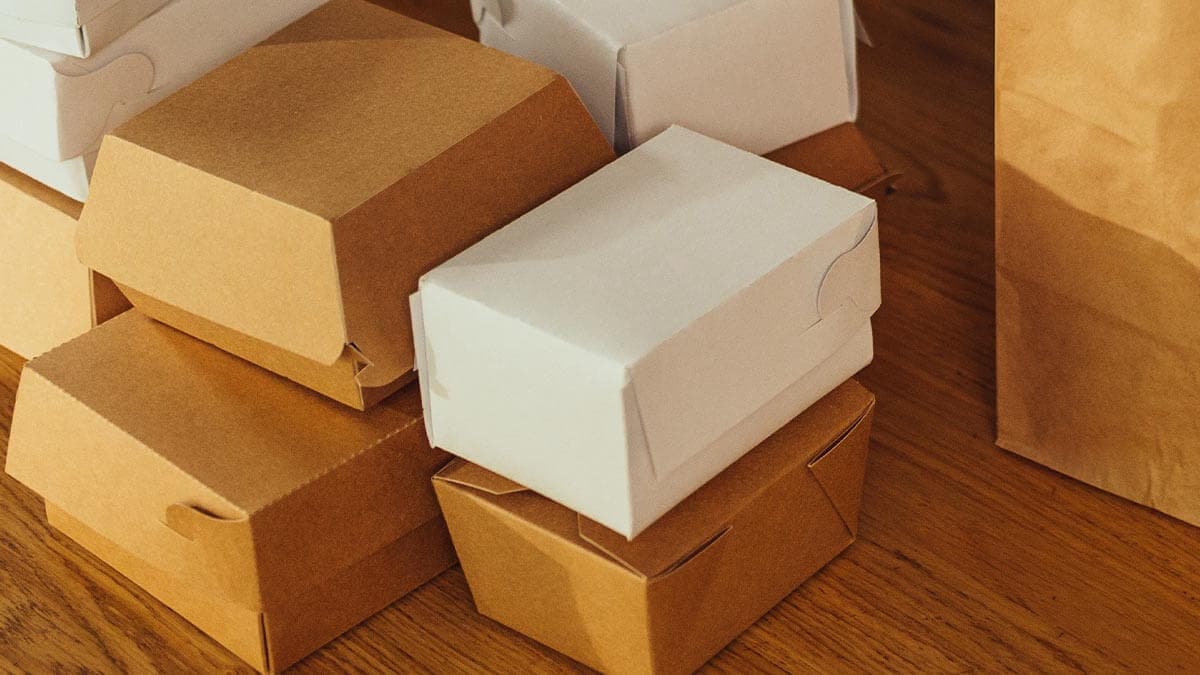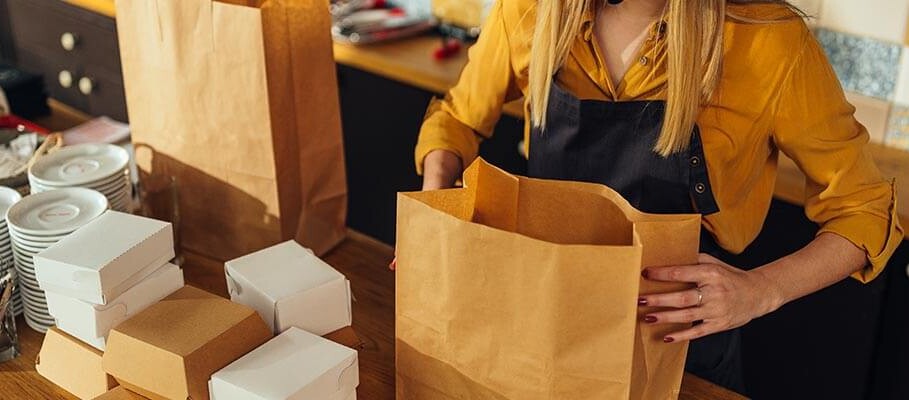Table of Content
- The Foundation of Food Safety in Restaurant Packaging
- Innovations in Materials for Hygienic Restaurant Packaging
- Tamper-Evident Restaurant Packaging: Ensuring Integrity
- Restaurant Suppliers: Navigating the Challenges of Food-Grade Materials
- Best Practices for Restaurants in Handling Food Packaging
- Pro Tip
- Restaurant Supply Chain: Ensuring Food Safety from Production to Delivery
- Wholesale Packaging Supplies: Meeting the Demand
- Sustainability in Restaurant Packaging: A Growing Imperative
- Conclusion
1. The Foundation of Food Safety in Restaurant Packaging
Effective packaging is crucial for food safety in delivery and takeout, as it protects food from outside contamination. It keeps food safe from physical, chemical, and biological hazards while being transported.
For restaurants, choosing the right packaging is an important decision that affects both customer health and the restaurant's reputation.
Physical contaminants like dust and dirt can spoil food if the packaging isn't strong enough. Packaging must create a solid barrier using durable containers and secure seals.
Chemical contamination, where harmful substances from packaging materials leak into food, is also a concern. It's important to use food-safe materials that won’t release harmful chemicals—this is a key responsibility of businesses that provide restaurant supplies.
Biological hazards like bacteria and viruses can also be a major threat. Poor packaging can cause temperature changes and moisture buildup, which can allow germs to grow. So, restaurant packaging must keep food at the right temperature, control moisture, and prevent harmful microorganisms from getting in.
For further information on this subject, you can refer to this insightful study on the National Library of Medicine, Food packaging’s materials: A food safety perspective - PMC.
2. Innovations in Materials for Hygienic Restaurant Packaging
New developments in material science have created smart packaging options that improve food safety.
Here are some notable advancements for restaurant packaging:
- Antimicrobial Packaging: This type of packaging contains agents that slow down the growth of microorganisms, helping food last longer and reducing spoilage risks. These agents can be integrated into the material or applied as a coating.
- Active Packaging: Some advanced materials can release or absorb substances to keep the environment inside the package safe and stable. For example, they might release antioxidants or absorb excess moisture.
- Biodegradable and Compostable Materials: Made from renewable sources, these materials provide an eco-friendly alternative to traditional plastics and often come with added benefits for food safety. For instance, some plant-based materials naturally fight bacteria, giving food extra protection.
- Nanotechnology Enhancements: Incorporating nanotechnology improves barrier properties, reducing permeability to gases and moisture. Nanosensors can also be embedded to detect spoilage, offering real-time food safety monitoring.
These innovations offer restaurants and restaurant suppliers powerful tools to improve food safety, extend shelf life, and address consumer demand for sustainability in restaurant packaging.
3. Tamper-Evident Restaurant Packaging: Ensuring Integrity
Tamper-evident restaurant packaging has become essential in the world of food delivery. This type of packaging shows clear signs if it has been opened or tampered with during transit, giving both restaurants and customers added confidence.
Tamper-evident designs can include seals, bands, or films that tear or change appearance when disturbed.
For restaurant suppliers, offering these options is key to keeping the food supply chain secure, especially since food often passes through several hands before it reaches the customer.
Using tamper-evident packaging helps lower the chances of accidental or intentional tampering, protecting the food’s quality.
It also ensures compliance with legal rules, as some areas now require tamper-evident packaging for certain food deliveries.

4. Restaurant Suppliers: Navigating the Challenges of Food-Grade Materials
Restaurant supplies are crucial for making sure restaurants have safe and approved packaging materials. This involves understanding the rules about food contact substances.
Restaurant suppliers must handle certifications, meet testing requirements, check documents, and sometimes do their own testing to ensure products are safe.
One major challenge is ensuring materials are high-quality and authentic, especially when sourcing from other countries. Complex supply chains make it hard to track materials and confirm they meet standards.
To handle this, businesses need strong partnerships with manufacturers and strict quality control processes, like regular inspections and keeping detailed records.
Restaurant suppliers also need to keep up with new risks and changing rules for food contact materials. Since regulations are always changing, they must stay ahead, adjust their plans, and give restaurants helpful, up-to-date advice.
If you're a supplier facing these challenges and seeking expert guidance, you can request a consultation with our team here: Develop your business with europages
5. Best Practices for Restaurants in Handling Food Packaging
Proper handling of food packaging is just as important as the quality of the packaging itself.
Restaurants need to establish clear protocols for receiving, storing, and using packaging materials to prevent contamination. Staff training is crucial to ensure that all employees understand the importance of hygiene and follow established procedures.
Here are some key measures to implement:
Receiving:
- Inspect all incoming shipments of packaging materials for signs of damage, contamination, or tampering.
- Verify that the delivered goods match the order specifications and comply with safety standards.
- Reject any shipments that appear compromised or do not meet the required criteria.
Storage:
- Store packaging materials in a clean, dry, and well-ventilated area.
- Keep packaging materials off the floor and away from walls to prevent moisture absorption and pest infestation.
- Protect packaging from exposure to direct sunlight, extreme temperatures, and potential contaminants (e.g., chemicals, cleaning agents).
Inventory Management:
- Implement a first-in, first-out (FIFO) system to ensure that older packaging materials are used before newer ones. This helps to minimize the risk of material degradation and ensures optimal performance.
- Maintain accurate inventory records to track the usage and flow of packaging materials.
Handling:
- Train staff on proper hygiene practices when handling packaging materials, including handwashing and the use of gloves when appropriate.
- Avoid using damaged or contaminated packaging materials.
- Ensure that packaging materials are properly sealed after use to prevent contamination of the remaining contents.
Regular Inspections:
- Conduct routine inspections of stored packaging materials to check for signs of damage, deterioration, or contamination.
- Remove and discard any compromised packaging materials immediately.

6. Pro Tip
For B2B professionals in the restaurant industry, taking a proactive approach to food safety in packaging can bring great benefits. Consider adding a "Packaging Safety Audit" to your regular quality control process, reviewing all packaging materials and procedures.
Involve your restaurant suppliers in this review to share their knowledge. Treating them as partners creates a collaborative environment focused on continuous improvement.
This boosts food safety, strengthens your supply chain, reduces waste, and can lead to cost savings. It can also encourage innovation, as suppliers may be more willing to share new products and help customize solutions.
7. Restaurant Supply Chain: Ensuring Food Safety from Production to Delivery
The restaurant supply chain for packaging involves a collaborative effort to ensure food safety.
Here's a breakdown of the key players and their responsibilities:
- Manufacturers: Responsible for producing food-grade packaging materials that meet strict safety standards, ensuring they are free from harmful substances, provide adequate protection, and maintain consistent quality through rigorous control measures.
- Distributors: Responsible for storing packaging materials under proper conditions (e.g., temperature, humidity, pest control), transporting them safely and efficiently to restaurants, and maintaining accurate records of inventory and shipments.
- Restaurants: Responsible for receiving and inspecting packaging materials upon delivery, storing them properly, training staff on correct handling and use to prevent contamination, and utilizing packaging correctly during food preparation and service.
Communication and teamwork between all parties are key. Sharing information, setting clear guidelines, and quickly addressing any concerns are all important to keep things running smoothly.
Traceability is also an essential part of the supply chain. Restaurants must be able to trace packaging back to its source to make sure it’s safe, confirm where it came from, and find out if there are any issues. A strong traceability system helps quickly solve problems, minimizing risks to food safety.
Technologies like blockchain can greatly improve traceability in the restaurant supply chain. It creates a transparent and unchangeable record of the packaging’s journey, allowing for real-time tracking, verifying authenticity, and boosting food safety.
8. Wholesale Packaging Supplies: Meeting the Demand
Wholesale packaging suppliers are essential for providing restaurants with the wide range of packaging solutions they need.
These suppliers must offer different materials, sizes, and designs to meet the specific needs of various foods and service models.
As the demand for specialized packaging, like tamper-evident and eco-friendly options, grows, wholesale suppliers are expanding their product offerings and staying updated on industry trends.
They also help restaurants by teaching them about new packaging technologies and guiding them to choose the best options for their needs. Maintaining strong relationships with manufacturers and staying informed about changes in regulations helps wholesale packaging suppliers ensure they provide high-quality, compliant products to their customers.
If you need assistance with this process, you can contact our team here: https://www.europages.fr/en/rfq
9. Sustainability in Restaurant Packaging: A Growing Imperative
Sustainability is becoming a big focus in the restaurant packaging industry. More and more people are concerned about how single-use packaging harms the environment, especially when it comes to plastic waste and pollution.
Because of this, many consumers are asking for more eco-friendly packaging options from the restaurants they visit. This change in what people want is making restaurants rethink how they use packaging.
To meet this demand, restaurants are looking for more sustainable packaging solutions. They’re choosing materials made from recycled or renewable sources.
Some examples include:
- Paper and Cardboard: Packaging made from recycled paper and cardboard is popular. These materials can be composted or broken down easily, which helps the environment.
- Plant-Based Plastics: Bioplastics, made from things like corn starch, sugarcane, or seaweed, are becoming more common. These are better alternatives to regular plastic and can sometimes be composted or broken down.
- Mushroom Packaging: Packaging made from mycelium, the root of mushrooms, is compostable and biodegradable.
- Bagasse Packaging: Bagasse is a material made from sugarcane leftovers. It’s strong, compostable, and used to make food containers.
This push for sustainability also brings chances for new ideas. Companies are spending money on research to create better materials and designs that are both useful and good for the environment. For example, some are looking into edible packaging, packaging made from farm waste, and reusable containers.
Restaurant suppliers are responding by offering more sustainable packaging options. They help restaurants choose the best options by offering packaging made from recycled materials, plant-based products, and other creative solutions.
It’s important to remember that sustainability should never risk food safety. New packaging materials still have to meet safety rules to keep food safe. They must protect food, stop contamination, and follow regulations for materials used with food.
For more information about food packaging solutions, read these insightful articles:
- Edible Food Packaging: A Sustainable Future?
- Stainless Steel in Food Processing: Highest Hygiene
- Restaurant Packaging: Boost Your Brand Identity
- Why Are Bottle Caps Attached? Understanding the Tethered Caps Transition for Businesses
- Sustainable Soft Drink Packaging: Aluminum & Returnables
.png)
10. Conclusion
Restaurant packaging is changing quickly due to the rise in takeout and delivery, food safety concerns, and a focus on sustainability.
Good packaging is important because it protects food from contamination throughout the supply chain. New materials like antimicrobial and biodegradable options help improve safety and reduce environmental harm.
Restaurant suppliers are key in providing these new solutions and ensuring they meet regulations. Working together across the supply chain, from manufacturers to wholesale suppliers, is important to keep food safety standards high.
In the future, smart technology might play a big role in restaurant packaging. How can things like IoT and data management help improve delivery, cut waste, and personalize customer service? Using smart technology in packaging could bring better efficiency, safety, and customer satisfaction while reducing waste and energy use.
Find restaurant packaging solutions for your project!
Atlas Export Packaging: Is a global supplier of customizable, eco-friendly packaging solutions, offering a wide range of products from paper cups and food containers to reusable bags, all designed to meet diverse business needs with a focus on sustainability.
XENOS Packaging: Is a Greek manufacturer of customizable food packaging solutions, offering a wide range of paper and sustainable bags designed to enhance brand visibility and meet European standards, all delivered with speed and a commitment to customer satisfaction.
ArDelSan Packaging: Is a Turkish-based provider of high-quality, sustainable paper packaging solutions for the food, cosmetics, and pharmaceutical industries, offering a wide range of customizable options, from hygienic food containers to elegant retail and e-commerce packaging, all designed with a commitment to environmental responsibility.
NX Print / Packaging: This Romanian-based printing company specializes in high-quality offset printing for a variety of sectors, including food, beverage, and pharmaceutical, offering a wide range of packaging and promotional materials with luxury finishes like hot foil stamping and embossing, all delivered with a commitment to fast turnaround and exceptional customer service across Europe.
Bi'ince packaging: Based in Turkey, offers over 25 years of experience in design and printing services, specializing in food packaging alongside cosmetics, utilizing the latest technologies to create impactful branding and customized solutions for both domestic and international clients.
PLASTOBREIZ & PLASTOLOIR: Are French family-owned companies with over 45 years of experience specializing in eco-friendly thermoformed plastic food packaging, offering custom and recyclable solutions for vacuum, gas, skin, freezing, and thermal treatment processes, all backed by ISO 9001 and BRCGS certifications.
Bandall: Is an international family business specializing in sustainable bundling and labeling solutions using innovative banderolling technology, offering a wide range of machines that wrap products with a thin band of paper or foil, significantly reducing packaging material usage across various industries.
Fleros Kunststoffe GmbH: This company specializes in manufacturing a wide range of food-safe plastic packaging, including round and rectangular trays, containers, buckets, and lids, catering to diverse industries such as food processing, delicatessen, and fresh produce with a focus on high-quality, customizable solutions.
Grossiste Francilien: Is a dedicated supplier of high-quality, affordable, and eco-friendly food packaging solutions specifically designed for restaurateurs, ensuring both product protection and reliable delivery.
UZUNLAR Baskı ve Ambalaj: Is a Turkish printing and packaging company with over 40 years of experience, offering a wide range of solutions including offset packaging, paper bags, paper boxes, and specialized food packaging like noodle boxes, pizza boxes, and coffee carry bags, all designed to present and protect your products effectively.
AMC TEIXEIRA: Is a Portuguese manufacturer specializing in a wide array of food-contact paper and cardboard pastry items, including disposable trays, cupcake molds, cake boxes, and printable takeaway packaging, offering innovative and customizable solutions for bakeries and pastry businesses since 1998.
Dispo Plastik: Is a Istanbul-based manufacturer producing over 1000 tons of eco-friendly, recyclable plastic packaging monthly, specializing in IML food containers, disposable plates, cups, and cutlery, alongside other solutions for the food, agriculture, and industrial sectors, with a commitment to quality, affordability, and environmental responsibility.

